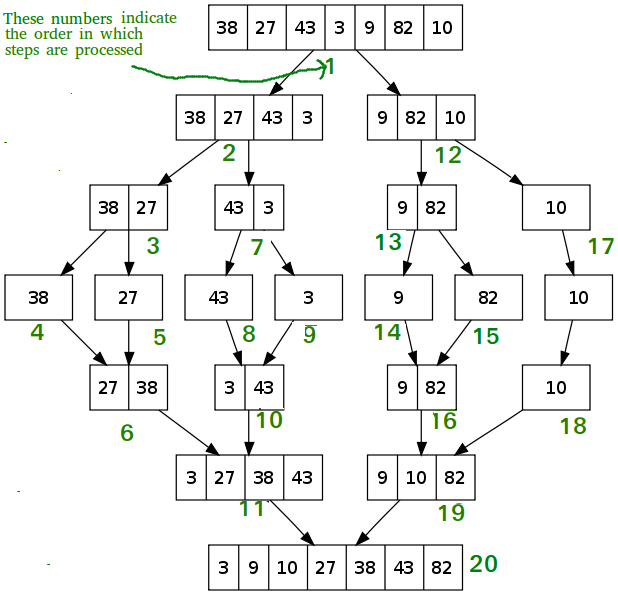Resources:
Merge sort uses a divide and conquer approach to sorting. The unsorted array is first split up into smaller arrays until one element remains. At this point, the single element arrays are then merged back into a final sorted array. This approach, like Quick sort, uses recursion.
Assume you need to sort an array of n numbers in the right order. The merge-sort algorithm works as follows:
- Put the numbers in an unsorted pile.
- Split the pile into two. Now, you have two unsorted piles of numbers.
- Keep splitting the resulting piles until you cannot split anymore. In the end, you will have n piles with one number in each pile.
- Begin to merge the piles together by pairing them sequentially. During each merge, put the contents in sorted order. This is fairly easy because each individual pile is already sorted.
Here's how it works:
-
If the array only has one element, return it
-
Call this function on the left side and the right side. Set these calls equal to variables left and right
-
Merge left and right together (assuming that left and right are sorted) and return that array
This can be a little tricky, so let's go through some examples.
var arr1 = [3,1]
- Skip this as there are two elements
- This call will return [3] and [1]
- Merge [3] and [1] to make [1,3] and return it
var arr2 = [3,1,8,2]
-
Skip this as there are four elements
-
We set left equal to this function passing in [3,1] and right equal to this function passing in [8,2] . As we see from example one, left = [1,3]. We can deduce that right = [2,8]
-
Merge [1,3] and [2,8] to make [1,2,3,8] and return it
var arr3 = [3,1,8,2,10,4,6,5]
-
Skip this as there are eight elements
-
We set left equal to this function passing in [3,1,8,2] and right equal to this function passing in [10,4,6,5] . As we see from example two, left = [1,2,3,8]. We can deduce that right = [4,5,6,10]
-
Merge [1,2,3,8] and [4,5,6,10] to make [1,2,3,4,5,6,8,10] and return it
func mergeSort<T: Comparable>(inputArray: [T]) -> [T] {
guard inputArray.count > 1 else { return inputArray }
let middleIndex = inputArray.count / 2
let leftArray = mergeSort(inputArray: Array(inputArray[0..<middleIndex]))
let rightArray = mergeSort(inputArray: Array(inputArray[middleIndex..<inputArray.count]))
return merge(leftPile: leftArray, rightPile: rightArray)
}
func merge<T: Comparable>(leftPile: [T], rightPile: [T]) -> [T] {
var leftIndex = 0
var rightIndex = 0
var orderedPile = [T]()
while leftIndex < leftPile.count && rightIndex < rightPile.count {
if leftPile[leftIndex] < rightPile[rightIndex] {
orderedPile.append(leftPile[leftIndex])
leftIndex += 1
} else if leftPile[leftIndex] > rightPile[rightIndex] {
orderedPile.append(rightPile[rightIndex])
rightIndex += 1
} else {
orderedPile.append(leftPile[leftIndex])
leftIndex += 1
orderedPile.append(rightPile[rightIndex])
rightIndex += 1
}
}
while leftIndex < leftPile.count {
orderedPile.append(leftPile[leftIndex])
leftIndex += 1
}
while rightIndex < rightPile.count {
orderedPile.append(rightPile[rightIndex])
rightIndex += 1
}
return orderedPile
}
var list = [10, 0, 3, 9, 2, 14, 8, 27, 1, 5, 8, -1, 26]
mergeSort(inputArray: list) // [-1, 0, 1, 2, 3, 5, 8, 8, 9, 10, 14, 26, 27]Merge sort has a best, worst and average runtime of O(n * log(n))
Source: https://www.geeksforgeeks.org/wp-content/uploads/Merge-Sort-Tutorial.png
